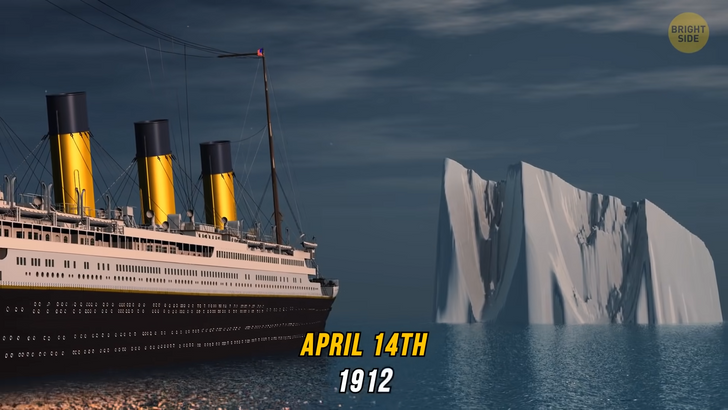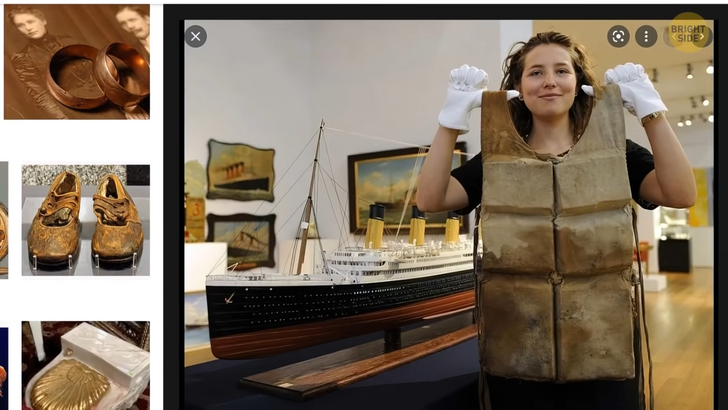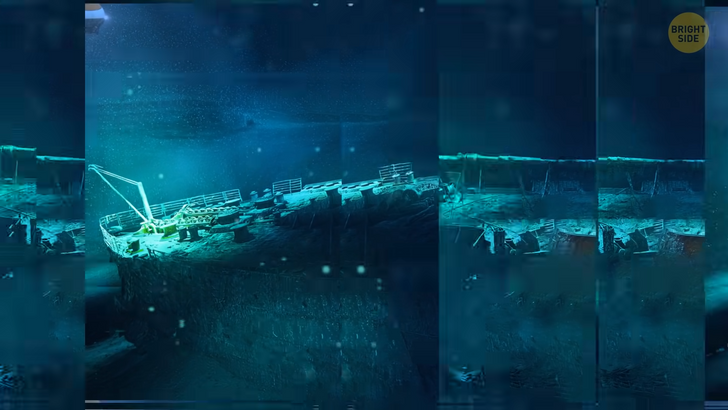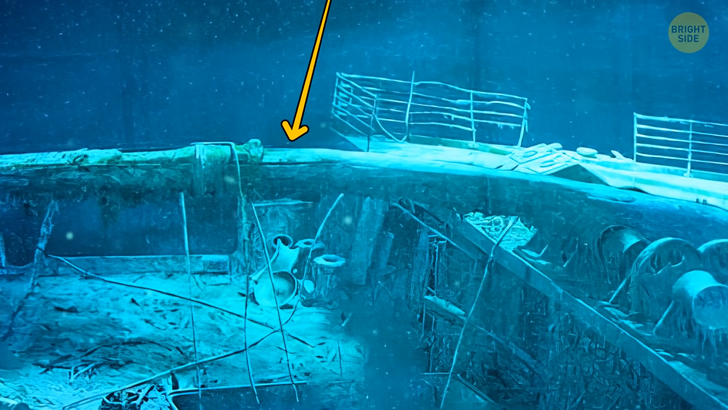12 People Who Unexpectedly Saw Something That Was Supposed to Stay Secret

Have you ever wondered how much of the Titanic is left these days? Now, if you haven’t been living under a rock, you probably know that it’s been over 100 years since the world’s most famous ship turned into a wreck. The RMS Titanic, the world’s largest sea liner from the beginning of the 1900s, sank during its maiden voyage, just a few days after leaving port.
The ship struck an iceberg on April 14th, 1912, taking down over 1,500 passengers of more than 2,200 who were on board the liner at that time. As shocking as this may sound, the Titanic took over three years to be built and only three hours to sink. And if it were today, the ship would have cost over 210 million dollars to be made.

It was last seen on the surface of the Atlantic at 2:20 AM. And for many decades, that was the last time people saw it. It wasn’t until 1985 that the whereabouts of the ship were discovered by oceanographer Robert Ballard. And some parts of the Titanic became visible once again.
One of the first discoveries made by Ballard’s expedition was that the ship was indeed torn in half before sinking. The early exploratory missions to the part of the ocean floor where the Titanic now lies could only see the hull and the deck of the ship. According to Ballard, the main purpose of these missions was to understand how to preserve the ruins from deteriorating. Another goal was to recover the huge number of personal items scattered along the seabed.
The explorer later said the view down there was as shocking as it was emotional. In the field of debris around the wreck, the oceanographer discovered plenty of small objects and personal belongings, many of which he brought back to the surface. There were shoes. Some fancier than others. There were pieces of clothing that belonged to crew members. There were huge propellers.
If on the surface, they gleamed and shined, on the ocean floor, they were embedded and devoured by sand. Ballard pointed out that the area where kitchenware was scattered measured more than a mile in length. There were enough plates, pots, and pans to fill up an entire industrial kitchen.

For the first time ever, 3d animation footage reveals exciting images. The simulations show the Titanic’s evolution from when she first set sail in 1912 until the state of her ruins today. But simulations weren’t enough for deep-sea explorer James Cameron, who envisioned traveling to the heart of the wreck for the first time ever in the history of the ship. Yep, the same James Cameron who happens to be the director of a very famous movie about the ship.
He has now dived 33 times to visit the wreck of the Titanic. Here’s some fun trivia for you: the director says that his true passion has always been the ocean. And that ever since he was a kid, he wanted to study the sea. Directing, let’s say, just happened to be his day job. And when the possibility of directing Titanic appeared, he said yes just so that he could go and check out the ruins of the ship in real life!
Now, back to the wreck. According to James Cameron, it wasn’t enough for researchers to access only the exterior of the ship. They needed to go inside, analyze and photograph what was left of the pompous interiors of the world’s once biggest sea liner. Cameron piloted an innovative robot vehicle equipped with cameras. It helped the man to reveal spaces in the Titanic that no one had ever seen before — since the ship touched the bottom.
Turkish baths, for instance, still had their tiled walls standing up almost in all their entirety. These baths were exclusively for first-class passengers. They were located right next to the Swimming Bath and the Third-Class Dining Room and were designed in the Moorish style. People resting there could get heating blankets and ask waiters to bring them anything they needed.

If the pictures from before the disaster were astonishing, they carry a different kind of wow factor now — when everything you see in them is hidden underneath the surface of the water. Another shocking discovery was the ship’s mast. If we look at the Titanic in its pre-sinking glory, the mast calls much of one’s attention. Located on the bow of the huge ship, the mast held together the transmission cables for the Marconi system — a system of wireless telegraphy.
That’s also where the British merchant flag the Titanic flew was located. The mast stood at the height of a bit more than 100 feet and was equipped with a crow’s nest. Nowadays, the mast is unrecognizable. Attacked by corrosion, it collapsed. The crow’s nest broke apart, too.
Now, we can see why the modern-day Titanic is a real treasure for deep-sea explorers. But as the wreck of the ship lies at an approximate depth of 12,500 feet, sunlight is nonexistent there. So, piloted missions depend on high-end technological equipment to survey the area. Why do you think the Titanic went missing from the public eye for over 70 years?
Well, because at that time, technology wasn’t advanced enough for people to go down there, as well as bring back good footage of the wreck. Filmmakers were the ones who drove this technology to its advance by trying to film underwater. They began by building boxes to put their cameras inside. And now, deep-sea photography is highly advanced and allows us to marvel at the awesomeness of underwater life.

Of course, taking pictures under the sea is no easy feat. For one thing, to withstand that crazy underwater pressure, submarines need to be really strong and have thick walls — no thinner than 11 inches! Plus, explorers need to understand how to film and photograph when there’s almost no light around. There was another thing that made documenting the Titanic even more difficult.
When the wreck of the ship was rediscovered by scientists, it was covered with red-colored rusty bacteria that made it even harder to take good pictures. As it happens, the color red does not reflect well underwater, which is unfortunate for photographers. For this reason, human-operated vehicles that go down to tour the ruins are equipped with powerful lighting devices.
When you see some parts of the ship from afar, they look as if reddish-brown wax has been dripping all over the Titanic’s ruins. But in reality, these icicle-shaped structures are colonies of microorganisms. When the ship sank, it brought down with it an enormous amount of bacteria that hadn’t existed at the bottom of the ocean before.
But now, these bacteria, together with the extreme conditions at the bottom of the ocean, have turned into a disastrous combination for the ruins of the ship. These red colonies of microorganisms actually feed off of iron and steel, which is basically all that is left of the Titanic.

One kind of those microorganisms are bacteria called Halomonas titanicae. They can eat up to 220 lbs of iron per day. This makes the Titanic a colossal food source for them. There have been lots of speculations regarding the life expectancy of the ship’s wreck after researchers discovered this bizarre rust.
But according to Cameron and his research team, the Titanic isn’t going to disintegrate anytime soon. In one of the latest expeditions down to the wreck, a piloted vehicle was funded to identify specifically one stateroom. It belonged to a very important passenger — Sir Benjamin Guggenheim. Yes, like the Museum.
Guggenheim was the son of a mining magnate and a member of the elite group that boarded the transatlantic journey of the Titanic. Born in Philadelphia, Guggenheim was traveling back home to the US. But as we all know — he never made it to his final destination.
For the price that ranged from 400 to 800 pounds back in 1912, the equivalent of 84,000 pounds nowadays, one could book accommodation that was called a stateroom. Staterooms on the Titanic were the most luxurious kind of first-class rooms. They were located on the B or C decks and were decorated in more than 11 different styles, ranging from Jacobean, Georgian, Italian Renaissance — and the list goes on.

These rooms were filled with carved paneling and marquetry made from exotic and rare kinds of wood, such as mahogany, oak, and so on. Guggenheim occupied one of these luxurious rooms.
And a hundred years later, one of his descendants funded an entire mission just to locate the precise stateroom the man stayed in. This expedition turned into a documentary for National Geographic. And they did manage to identify which stateroom was Guggenheim’s, so kudos for them!











